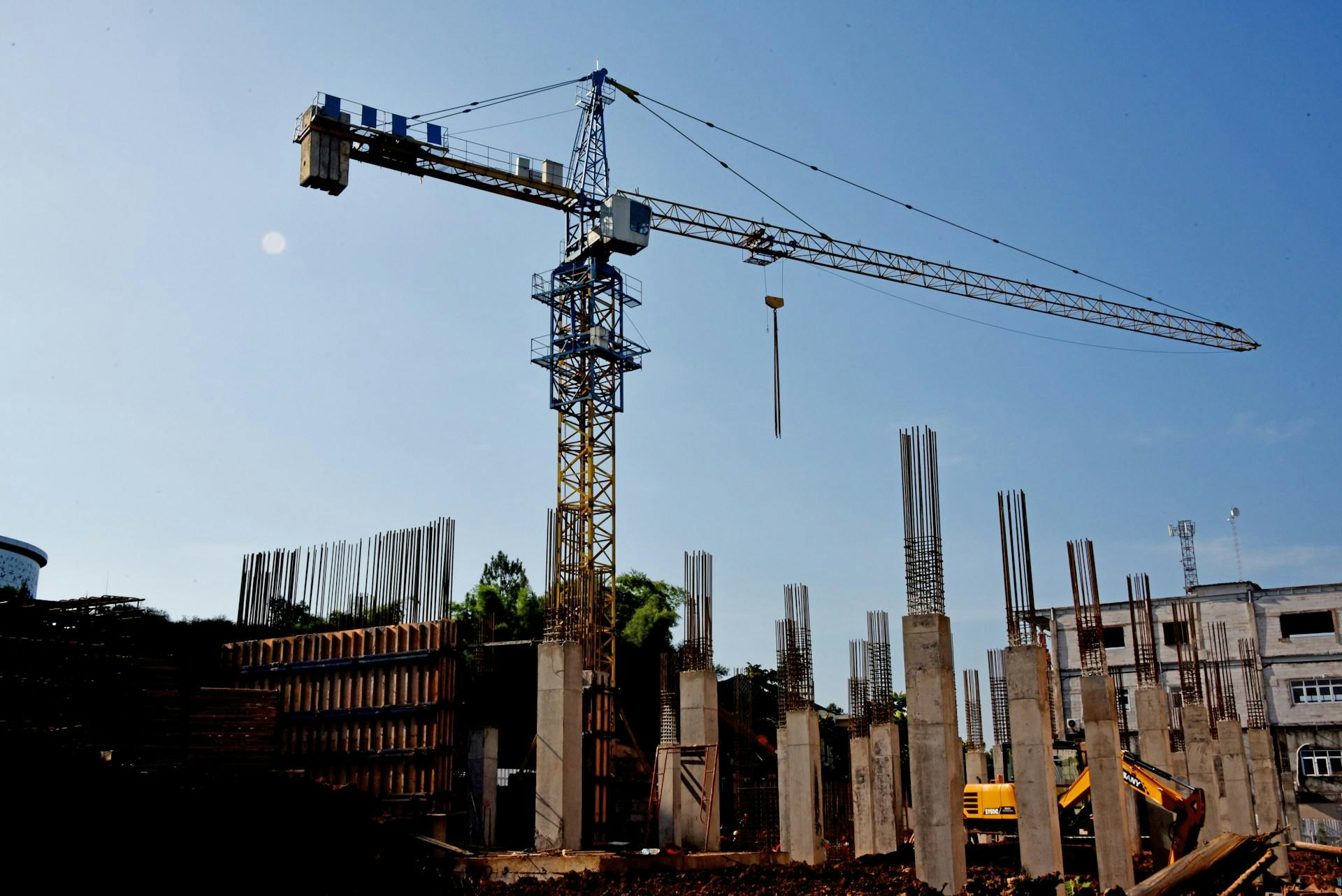Complete Guide to Managing Construction Delays: Tips, Tools, and Best Practices


Construction delays are one of the biggest challenges facing the industry today. They disrupt schedules, inflate budgets, and strain relationships between contractors, clients, and suppliers.
In North America, nearly all construction projects experience delays, often extending timelines by more than a third. These setbacks come with significant financial consequences, including costs for idle equipment, workforce downtime, storage fees, and potential penalties.
While delays may seem unavoidable, many can be managed or mitigated with the right strategies and clear communication. This guide explores the causes and impacts of construction delays and offers practical tips, tools, and best practices for effective delay management.
Common Causes of Construction Delays
Effectively managing construction delays starts with understanding the main causes behind them. Delays disrupt project timelines, inflate budgets, and strain relationships. By knowing what typically trips up construction projects, teams can take proactive steps to prevent or mitigate these issues. Here are the most common causes of construction delays:
Design Changes and Scope Creep
One of the most common causes of construction delays is changes to the design or project scope after work has started. Such changes disrupt established schedules and interfere with the careful allocation of resources. The best way to minimize these risks is to complete thorough planning and design reviews before breaking ground, ensuring that all stakeholders agree on the project’s vision and requirements early on.
Despite thorough planning, some changes are inevitable. To manage them effectively, it is essential to establish a strict change order process that documents every requested modification along with its potential impact on the project timeline. This process protects the project team when questions arise later and helps manage client expectations by providing clear visibility into how changes affect delivery dates.
To further strengthen this process, many projects implement a change review board that evaluates proposed alterations before approval. This board assesses the ripple effects of changes on schedules, costs, and resources, ensuring informed decisions. Regular stakeholder meetings are also vital to monitor progress against original plans, identify emerging scope issues early, and agree on necessary adjustments promptly.
Finally, when changes are approved, having predetermined pricing and timeline adjustment policies in place allows the project team to implement modifications quickly and transparently, reducing delays and maintaining trust among all parties involved.
Poor Planning and Scheduling
Poor planning and unrealistic schedules are foundational causes of many construction delays. When projects begin with underestimated task complexity or overly optimistic timelines, they are set up for failure from the start. To avoid this, creating realistic schedules grounded in historical performance data and input from experienced team members is essential.
Detailed work breakdown structures help identify task dependencies and resource requirements, revealing potential bottlenecks before they occur. Incorporating sufficient float time for complex or high-risk activities builds resilience into the schedule, allowing flexibility to absorb minor setbacks without jeopardizing the overall timeline.
Regular schedule audits that compare planned progress with actual performance provide early warnings of potential delays. Planning must also consider regional factors such as seasonal weather patterns, local permitting timelines, and labor market conditions, as these external influences affect work pace and resource availability.
Modern scheduling techniques like the Critical Path Method (CPM) and the Last Planner System improve accuracy by emphasizing workflow reliability rather than arbitrary deadlines. The most successful schedulers regularly refine their approaches based on lessons learned from past projects, continuously improving schedule realism and effectiveness.
External Factors
Many construction delays arise from forces outside the project team’s control. Among the most common are severe weather events, regulatory changes, permit delays, and supply chain disruptions.
Weather remains a particularly unpredictable factor, with climate change increasing the frequency of extreme conditions such as flooding, excessive heat, and unseasonable storms. These events can halt work completely and damage partially completed structures. Proactively monitoring long-range weather forecasts enables teams to adjust schedules in advance when possible, minimizing disruption.
Regulatory factors also contribute to delays, especially when code interpretations change during construction or inspectors provide conflicting compliance requirements. Maintaining open and consistent communication with regulatory bodies helps anticipate and navigate these changes effectively.
Supply chain disruptions have grown increasingly problematic in recent years, with material availability and delivery times fluctuating widely. Developing relationships with multiple suppliers and ordering long-lead items early provide important buffers against procurement delays.
Finally, broader political and economic conditions such as interest rate fluctuations, labor legislation changes, and funding availability can impact project timelines. Teams that stay informed about these trends are better prepared to create contingency plans and reduce the risk of external disruptions derailing progress.
Financial Difficulties
Financial challenges are a frequent cause of construction delays, often stemming from incomplete or inaccurate initial budgets. Contractors sometimes submit unrealistically low bids to win projects, only to face financial strain when actual costs exceed estimates. This can result in corner-cutting or even work stoppages when funds run short.
Delays also occur when owners withhold payments due to disputes or their own cash flow problems. Without steady income, contractors struggle to pay suppliers and workers, which slows progress as resources become scarce. Additionally, project financing arrangements can add complexity, especially if lenders change requirements or release funds only upon reaching specific milestones.
Economic fluctuations affecting material costs, interest rates, and currency values introduce further budget pressures that were not anticipated during planning. To mitigate these risks, it is important to establish clear payment terms, maintain up-to-date cash flow projections, and create financial contingency reserves.
Regular budget reviews help catch financial issues before they escalate. Open and transparent financial communication between all parties builds trust and facilitates faster resolution of problems, helping to keep projects on schedule.
Labor and Resource Shortages
A persistent shortage of skilled labor continues to challenge the construction industry. As experienced workers retire faster than new ones enter the field, competition for qualified personnel—especially in specialized trades like electrical work, plumbing, and HVAC installation—intensifies.
Projects frequently face delays when critical positions remain unfilled or when less experienced workers require additional supervision and training. Material shortages add another layer of complexity, as manufacturing disruptions and shipping delays affect everything from structural steel to microchips used in building systems.
Even when materials are available, quality issues may lead to rejections and reorders, causing further delays. Equipment failures and maintenance problems also contribute, particularly when specialized machinery is difficult to replace quickly. Moreover, labor productivity varies based on worker experience, site conditions, and team dynamics, making accurate scheduling challenging.
To minimize these impacts, forward-thinking companies invest in workforce development programs, maintain relationships with multiple material suppliers, implement preventive equipment maintenance, and use resource planning software to optimize labor and material allocation.
Communication Failures
Communication breakdowns occur at multiple levels throughout construction projects and are a significant cause of delays. Information silos between design teams, contractors, subcontractors, and clients often prevent critical details from reaching decision-makers on time. Misinterpreted specifications can lead to costly rework when installations do not align with the design intent.
Cultural and language differences on multinational or diverse project teams create additional communication challenges, making it essential to overcome language barriers to maintain clarity. Field teams frequently lack easy access to updated drawings and specifications, resulting in work based on outdated information.
Traditional hierarchical communication chains in construction slow the flow of information, especially for urgent issues requiring quick decisions. Unclear roles and responsibilities further complicate matters by creating confusion over who should address problems, leaving some issues unresolved. Documentation gaps also hinder tracking of decisions and changes, often leading to disputes about what was agreed upon.
Modern communication tools, such as project management software and messaging platforms, can help bridge these gaps. However, adoption varies widely across the industry.
One particularly effective solution is SMS-based communication. SMS reaches workers instantly on any mobile phone, regardless of internet access or smartphone availability, and works well even in areas with spotty reception. Its simplicity ensures messages are read quickly, enabling real-time updates, clarifications, and confirmations that reduce misunderstandings and delays.
Teams that establish clear communication protocols, leverage SMS-based communication platforms alongside other tools, hold regular coordination meetings, and maintain accessible documentation experience fewer delays caused by miscommunication. Implementing these solutions is essential for minimizing delays related to communication failures.
Types of Construction Delays
Understanding different types of construction delays helps with managing projects and resolving disputes. Here's a breakdown of the main categories:
Critical vs. Non-Critical Delays
Critical delays directly impact the overall project completion date, while non-critical delays affect specific parts of the project without extending the final timeline.
- Critical Delays affect tasks on the project's critical path. For example, a delay in foundation work will push back all subsequent phases such as structural framing, inspections, and finishing, ultimately postponing the project’s completion.
- Non-Critical Delays impact activities that have built-in scheduling flexibility or float. For instance, a delay in installing decorative signage or landscaping may not affect the occupancy date or final delivery.
Accurately identifying whether a delay is critical or non-critical allows project managers to prioritize attention where it matters most. This classification also supports requests for time extensions and helps avoid disputes. Experts emphasize that clear differentiation is necessary for fair scheduling decisions and to keep projects on track.
Excusable vs. Inexcusable Delays
This distinction centers on who is responsible for the delay.
- Excusable Delays occur due to unforeseen events beyond the contractor’s control, such as extreme weather events (hurricanes, floods), labor strikes, sudden regulatory or permitting changes, and natural disasters or “Acts of God.” In these cases, contractors are usually entitled to time extensions without financial penalties, provided they supply proper documentation.
- Inexcusable Delays result from the contractor’s own actions or mismanagement. Examples include poor planning or scheduling, inadequate staffing or equipment, and failure to manage subcontractors effectively. Such delays often lead to penalties, liquidated damages, or claims from the owner for additional costs or lost time.
Compensable vs. Non-Compensable Delays
This category determines whether financial compensation is applicable.
- Compensable Delays are typically caused by the owner or their representatives. Common causes include late information or approvals, mid-project design changes, and site access problems. Contractors may receive both time extensions and additional payment for these delays.
- Non-Compensable Delays might warrant a time extension but usually do not involve additional payment. Examples include most excusable delays like unusual weather events and delays where responsibility is shared.
Having clear contract language defining compensable and non-compensable delays helps prevent disputes.
Strategies to Manage and Mitigate Construction Delays
Construction delays can severely derail your project, but with smart strategies and the right tools, you can keep your work on track. Below are key approaches to proactively tackle delays and minimize their impact.
Proactive Communication and Coordination
Effective communication is critical to preventing small issues from escalating into major delays. Establishing clear and consistent communication channels helps keep everyone aligned and informed throughout the project.
- Assign a Primary Contact: Designate a single person as the main point of contact for the project. This centralizes decision-making and ensures messages are clear and consistent, reducing confusion among team members.
- Regular Check-Ins: Schedule frequent meetings and progress updates to review milestones, identify potential issues early, and make necessary adjustments. These check-ins keep all stakeholders on the same page and foster collaboration.
- Early Warning System: Implement a system to detect and report potential delays at the earliest stage. This might include automated alerts from project management software or simple reporting protocols that empower workers to flag risks promptly.
For construction workers in the field, Yourco’s SMS-based platform is highly effective because it works on any mobile phone, not just smartphones, ensuring no worker is left out. With AI-powered translations in over 135 languages, Yourco removes language barriers, making communication clear and inclusive for diverse teams. Instant delivery of time-sensitive updates keeps everyone informed. Moreover, with two-way communication, all workers are able to easily respond to messages and even provide quick feedback all via text with Yourco’s built in polling and survey functionality. Features like scheduled messaging and secure document sharing streamline communication, reduce misunderstandings, and keep deskless workers engaged and productive, no matter where they are or what device they use.
Effective Risk Management Plans
Smart risk management helps you stay ahead of potential construction delays:
- Thorough Risk Identification: Analyze your project schedule carefully to uncover hidden risks such as missing task dependencies, overlapping trades, or unrealistic timelines. Early identification allows you to address these issues proactively.
- Flexible Project Schedules: Build flexibility into your timelines by incorporating buffer periods to absorb disruptions like weather delays or material shortages. Experts recommend closely monitoring activities on the critical path since delays here directly affect the overall completion date.
- Continuous Progress Tracking: Use tools to monitor progress in real time, spotting delays early so corrective actions can be taken before problems escalate. Regular quality checks help catch defects or errors that might otherwise cause rework and further slow the project.
- Learn from Past Projects: Review data from previous projects to recognize common delay causes and successful mitigation strategies. Applying these lessons increases the chances of smooth project delivery.
Utilization of Project Management Software
Project management software streamlines construction workflows by offering visual scheduling and real-time progress tracking. It helps teams optimize labor and equipment through integrated resource management tools. Advanced platforms use predictive analytics to forecast potential delays and provide document management that reduces rework caused by outdated plans. Automated reporting minimizes administrative tasks, while financial integration links delays to their cost impacts. Cloud-based systems enable seamless collaboration across multiple locations, promoting quick and coordinated responses. Custom dashboards deliver role-specific views, from high-level overviews to detailed task management. When combined with BIM, the software connects schedules to 3D models, creating 4D simulations that make it easier to understand the effects of scheduling changes.
Breaking the Construction Delay Cycle: Your Path Forward
Forward-thinking construction teams know that preventing delays requires thorough planning, transparent communication, and the right technology. Building realistic schedules with buffer time and leveraging advanced project management software allows teams to identify and address potential issues before they escalate. Equally important is fostering a collaborative culture where every team member shares responsibility, enabling faster problem-solving when challenges arise.
Yourco directly addresses many of the challenges outlined in this article by providing a communication platform designed specifically for non-desk construction workers. It ensures that critical updates, schedule changes, and safety alerts reach every employee instantly, regardless of their location or device. Because Yourco works via simple text messaging, it overcomes barriers related to limited internet access, smartphone availability, or technical skills. There is no need for workers to download apps, remember passwords, or navigate complex systems, making communication seamless and inclusive.
By bridging communication gaps and supporting real-time information flow, Yourco helps construction teams improve coordination, reduce misunderstandings, and respond quickly to emerging issues. This level of connectivity empowers your entire workforce, driving efficiency and helping prevent costly delays before they start. Adopting a solution like Yourco means equipping your team with the tools they need to stay informed, engaged, and aligned throughout every phase of the project.
Try Yourco for free today or schedule a demo and see the difference the right workplace communication solution can make in your company.



